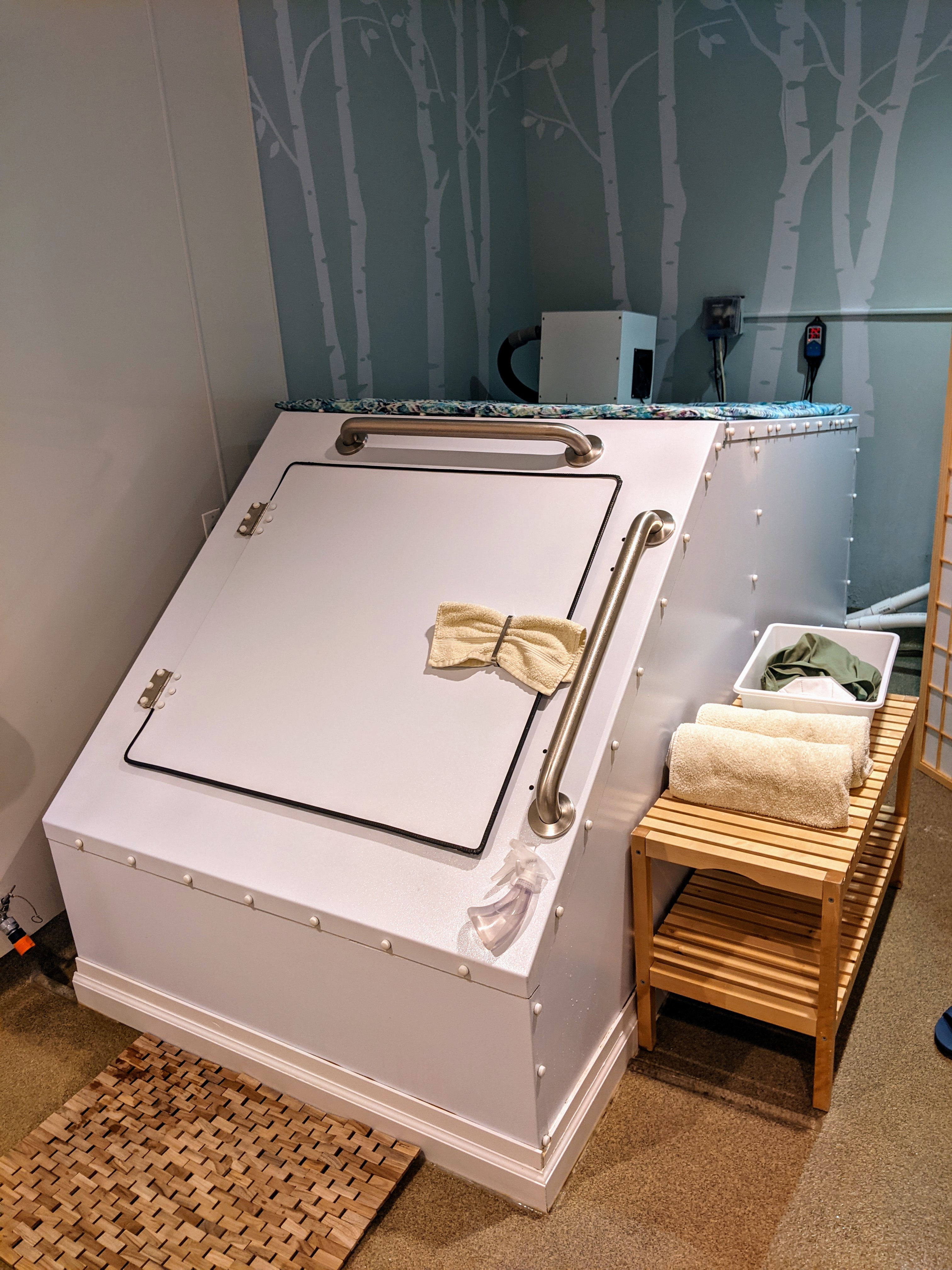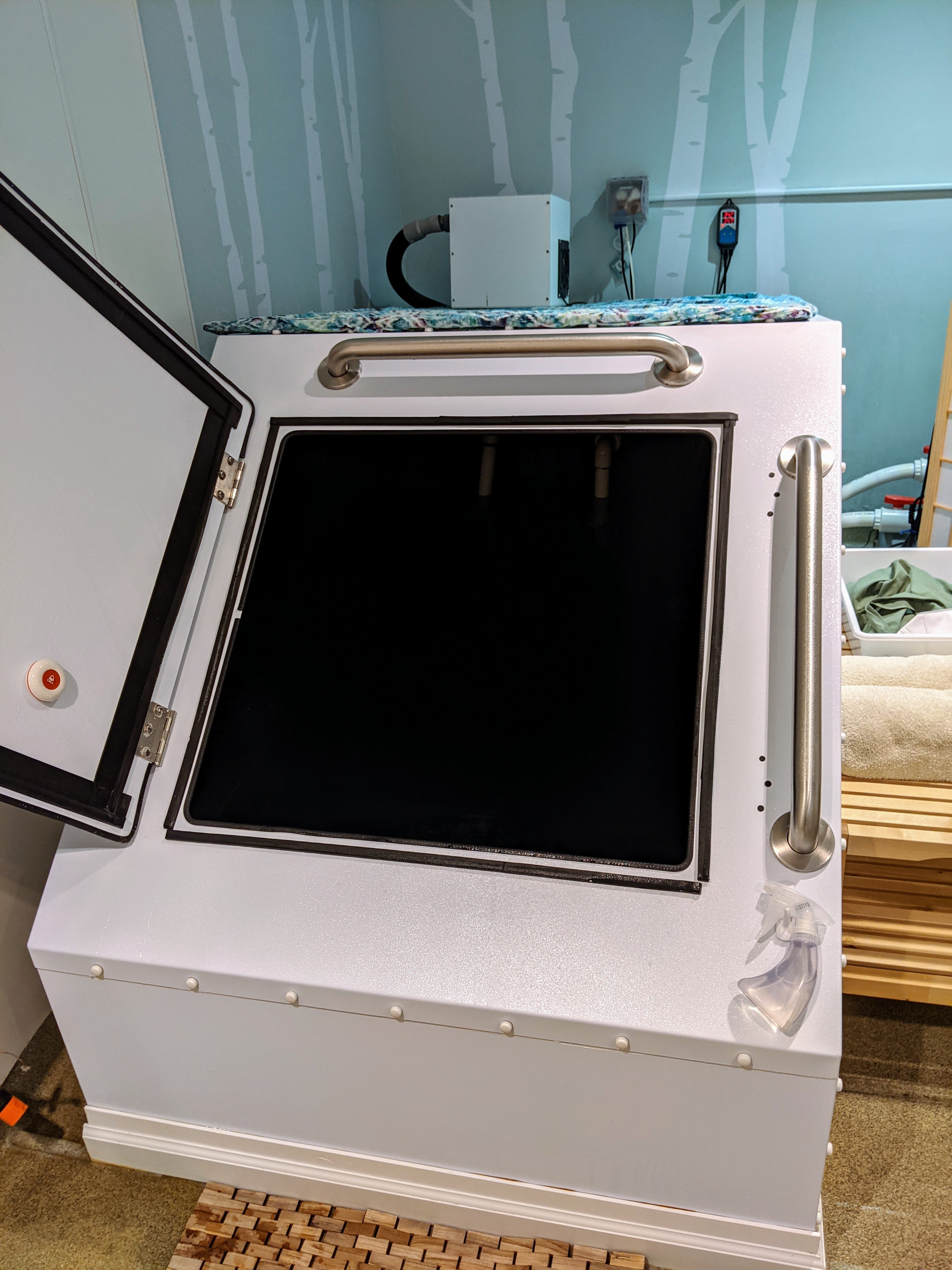
85 Hours of Sensory Deprivation
Last modfied: 07 January, 2025
Publish date: 22 January, 2022
What is it?
They're sometimes called float tanks, sensory deprivation tanks, or isolations tank. Tanks come in various forms, but the one I have most frequently used is pictured above. It’s been described to me as looking like a coffin. Which I can't really disagree with that but it's actually quite relaxing.
It’s got about a foot of water that’s the same temperature as your skin. The water has approximately 800-1000 pounds of epsom salt dissolved in it which is intended to create a specific gravity (i.e. you float effortlessly on top of the water). It’s pitch-black inside, it’s light-proof, and soundproof(-ish).
The primary function of the isolation tank is to eliminate as many of the external senses as possible. The creator of isolation tanks intended them to be used to explore the nature of human consciousness. Fancy feast. Full disclosure, he also began experimenting with taking psychedelics while inside the tanks about a decade after he created them.

How I found out about float tanks
Back in 2014-2015 I found out about isolation tanks when researching psychedelics and alternate ways to have psychedelic experiences without the drugs. This is also how I learned about holotropic breathwork (HB), Wim Hof Method (WHM), and transcendental meditation (TM).
My experience with TM was useful, but the culture around it seems a bit culty and weird to me. You basically repeat a "mantra" when you sit to meditate and do this twice a day for 20 minutes. I think you could achieve this without going through the TM community. There are plenty of other meditation options/apps. You could always just pick a mantra to repeat if you find this helpful.
HB reminds me of the Wim Hof Method (WHM) a bit. They both use breath to achieve a sort of meditative state. If you're interested Google both. I never tried HB and got varying results with WHM but did find it useful.
If you have additional interest the usage of psychedelics in a clinical setting, I found these books to be most helpful:
- DMT: The Spirit Molecule: A Doctor's Revolutionary Research into the Biology of Near-Death and Mystical Experiences by Rick Strassman
- Acid Test: LSD, Ecstasy, and the Power to Heal by Tim Shroder.
My first float session
I remember being anxious and afraid when I went for my first tank session. The staff took me into the room, explained what to do, and as she left she said, "If you get nervous, remember you can open the door and get out of the tank." She walked back to her desk, I shut the room door, got showered, and got into the tank.
15 minutes into the session I started to panic and get scared. I remembered what she said, "You can open the door and get out…". As soon as I had this thought it soothed me. I calmed down, realized I could just leave, and stuck out the full 90 minutes.
I have spent 85 hours inside of tanks since then. My longest session was approximately 3 hours.
What I find useful about them
The tank's environment creates a scheduled moment in my week that I feel obligated to go to but in a good way. It's like a forced break and when I'm in the tank I accept that there's nothing I'm going to do for the next 90 minutes but lay there which leaves room for me to think and reflect on my life.
This is particularily useful for me as I can get too easily distracted for too long, procrastinate, and begin feeling anxious because of it. The session helps me to notice this, reflect on what's wrong, what I'm putting off or avoiding, and come up with a solution or at least acknowledge that it's happening.
Different types of tank experiences
I typically have 4 types of experiences.
1: Falling asleep
If I am tired when I get into the tank I basically fall asleep. I generally dislike when this happens. It's a rather silly way to spend the time but becomes immediately obvious that I need to get my sleep under control.
2: Identifying procrastination
Being in the tank typically causes me to think about tasks I've been procrastinating or difficult conversations I've been avoiding. I then spend almost all of the 90 minutes thinking about these things. After the session I get this strong feeling of needing to address those problems (duh).
3: Tightness
If I'm well rested, and not procrastinating, I next recognize my body and how it's feeling. This typically causes me to start wiggling around and stretching as it's extremely distracting how uncomfortable my body feels. When I leave the tank, I take the next week to do more yoga, meditation, eat more consistently, etc.
4: A kind of high
If I am not tired, my life is in order, and my body feels good, then the tank session has a different life. I usually stare into the blackness and meditate or do a combination of meditation and the Wim Hof Method (breathing and retention). It's a very pleasant experience and depending on what I've been reading or listening to most recently, I'll usually think about that. For example, I once envisioned floating in space in the tank because I was listening to an audiobook from Neil DeGrasse Tyson.
These sessions are best when I don't think too much.
When these sessions go well and I leave the tank, colors are brighter, like the contrast is turned up. Touching things feels different, deliberate, specific. Hearing things feels strangely clear and listening to music sounds amazing. This is the tank session at it's best for me. I leave the building, get in my car, play beautiful music (no lyrics) and have an incredibly relaxing and calm drive home. I feel little to no stress after. This is the moment I float for.
Closing thoughts
All that said, I genuinely do not believe I need to do tank sessions. It's just a tool that happens to help me because I find it hard to schedule time to sit and do nothing. If you're able to set aside time in your week to sit (perhaps blind folded with ear plugs) and do nothing then you'd likely get a very similar effect.
Meditation could also be used instead as in some ways it's just meditating for a very long time and there's tons of research supporting meditation.
If you do get into a float tank, don't forget ear plugs (the salt is annoying to get out of your ears) and check yourself for cuts.
